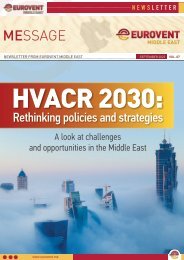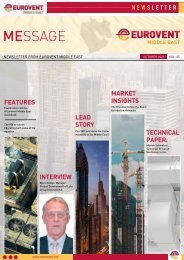EME Newsletter MEssage #01/2023
HVACR Industry news from Eurovent Middle East
HVACR Industry news from Eurovent Middle East
You also want an ePaper? Increase the reach of your titles
YUMPU automatically turns print PDFs into web optimized ePapers that Google loves.
LEAD STORY<br />
is a potential risk that regulations<br />
would be bypassed through the<br />
use of non-compliant thermostats<br />
available in the free market, as they<br />
are sometimes procured separately<br />
by customers or via e-commerce.<br />
“There is a need for uniform<br />
regulation application on other<br />
cooling systems such as chilled<br />
water systems.”<br />
Rangan further underscored<br />
that a lack of compliance and<br />
reduced accountability could lead<br />
to decreased safety and comfort<br />
for occupants, increased costs for<br />
individuals and businesses, and<br />
negative environmental impacts.<br />
“A lack of enforcement can erode<br />
confidence in regulatory systems,<br />
leading to a loss of trust for<br />
regulations,” he says.<br />
How this regulation will be managed<br />
within Building Management<br />
Systems (BMS) is another important<br />
aspect that needs to be addressed.<br />
Ghussein and Rangan believe it will<br />
add another layer of complexity<br />
to the discussion. “It’s unclear<br />
how they will regulate all the BMS<br />
coming into the market,” Ghussein<br />
says. “There would be a need to<br />
connect the unit to the BMS, the<br />
system should also ensure that the<br />
AC doesn’t go below 20 degrees C.”<br />
Currently, adds Rangan, remote or<br />
BMS controls are not regulated.<br />
Recommendations on the best way<br />
forward<br />
Without a doubt, the regulation<br />
will go a long way in achieving<br />
greater savings. “As an industry,<br />
we support the regulation to that it<br />
saves energy,” Ghussein reiterates.<br />
“In some countries, such as Japan,<br />
building codes have even been<br />
forbidden going below 24 or 25<br />
degrees C, which underscores the<br />
clear value behind having such a<br />
regulation. So yes, it’s good to have<br />
such a regulation. The question is,<br />
is the current requirement effective<br />
and working?”<br />
Rangan says that the importance of<br />
Rangan says that the importance of<br />
clearly defining testing standards<br />
and protocols for all thermostats<br />
entering the UAE should be<br />
emphasised. “The regulations<br />
should be uniformly applicable<br />
to all types of thermostats,<br />
and the exceptions process<br />
should be clearly defined,”<br />
he says. “This is because<br />
some end-use applications<br />
may not be practical to apply<br />
the regulations, for example,<br />
cold storage, pharmaceutical<br />
or hospital applications.<br />
Additionally, suppliers should be<br />
well protected in case of misuse<br />
of the thermostat settings in the<br />
field.”<br />
According to Rangan, several<br />
According to Rangan, several<br />
measures can improve<br />
compliance with regulations<br />
related to air conditioning<br />
units not cooling below a<br />
certain temperature. “Clear<br />
and consistent definitions of<br />
key terms and standardised<br />
measurement protocols are<br />
critical to ensuring effective<br />
implementation,” he says.<br />
“Certified testing organisations<br />
should also be required to<br />
test compliance with the<br />
regulations, and the regulations<br />
should be part of broader<br />
energy efficiency standards.<br />
Public education and outreach<br />
can also help raise awareness<br />
and promote compliance.”<br />
Lattner sums up the concerns of<br />
the industry, “The regulation in<br />
its current form is not achieving<br />
its goals. It doesn’t address<br />
applications where you need<br />
lower temperatures, leads to<br />
unfair competition in the market<br />
and leaves way too much room<br />
for circumventions. People will<br />
not understand why their AC<br />
can’t go lower when at the next<br />
location, the room temperature<br />
is clearly lower due to nonregulated<br />
BMS systems or a<br />
third-party remote control. We<br />
absolutely support its intention,<br />
but this issue may better be<br />
addressed through building<br />
codes and public awareness<br />
campaigns.”<br />
FEATURE ARTICLE<br />
Gopalakrishnan G, Operations<br />
Director, Emrill, an integrated<br />
facilities management company, is<br />
a firm believer in the importance of<br />
quality installation within the sector.<br />
“HVAC has many areas requiring<br />
specialist expertise,” he says.<br />
“Qualified and licensed technicians<br />
and engineers across the UAE<br />
possess the required skillsets to<br />
install and maintain HVAC systems<br />
efficiently.”<br />
However, complaints have emerged<br />
in the GCC region due to improper<br />
or inefficient installations, which<br />
not only put to risk the reliability<br />
of a system but also lead to<br />
costly maintenance or greater<br />
consumption due to it not operating<br />
as intended. Several common<br />
installation issues can be seen with<br />
DX air conditioning installations,<br />
says Srinivasan Rangan, Director<br />
of Demand Generation, Strategy<br />
and Regulatory Affairs, Rheem<br />
Manufacturing. “These include<br />
incorrect sizing, poor placement<br />
of the indoor and outdoor units,<br />
improper refrigerant charge,<br />
inadequate insulation, and poor duct<br />
design,” he says. “Additional factors<br />
that can contribute to issues with<br />
air conditioning systems include<br />
improper implementation,” he<br />
says, providing the example of low<br />
side static exceeding equipment<br />
design, hot air recirculation caused<br />
due to the equipment being placed<br />
too close, which does not follow<br />
the manufacturer‘s installation<br />
guidelines, as well as poor quality<br />
of refrigerant piping and inadequate<br />
brazing of joints or leakage in airflow<br />
ducts.<br />
For Hadi Ismail, Chief Sales Officer,<br />
Taqeef, improper installation<br />
practices are cost driven. “Often,<br />
when installers do not follow<br />
manufacturers' instructions or<br />
recommendations, the reason<br />
is purely economic,” he says. “A<br />
common example in the UAE is that<br />
they don’t install return duct to save<br />
money because it's expensive.”<br />
Gopalakrishnan points out, however,<br />
that with the number of HVAC<br />
solutions in the market, there is also<br />
an unavoidable learning curve. “FM<br />
is a fast-evolving sector,” he says.<br />
“With the implementation of any new<br />
product or service, there will be a<br />
learning curve across the industry,<br />
where support may be required from<br />
our original equipment manufacturer<br />
partners.”<br />
Why does it matter?<br />
NEWSLETTER<br />
What’s causing inefficient installations<br />
and why you should care<br />
Proper installation is a critical part of the project process that can significantly impact an<br />
HVAC system's efficiency, lifecycle, and overall performance. However, there are many<br />
cases in which quality installation is overlooked or simply not given the necessary attention<br />
it deserves. Eurovent Middle East looks at how poor installation processes lead to wrong or<br />
inefficient performance and operations and the reasons why…<br />
Gopalakrishnan G<br />
Subpar installation practices,<br />
unfortunately, has a number of<br />
consequences. Rangan explains<br />
that these issues he highlighted<br />
can result in inefficient operation,<br />
increased energy consumption,<br />
and costly repairs. “Proper<br />
installation, regular maintenance,<br />
and attention to these issues can<br />
help ensure optimal performance<br />
and longevity of the system,” he<br />
says. “If the air conditioning unit<br />
is not sized properly or has an<br />
incorrect refrigerant charge, it can<br />
lead to reduced efficiency, increased<br />
energy consumption, and a shorter<br />
lifespan. Similarly, insufficient<br />
insulation and poor duct design can<br />
cause inadequate cooling, increased<br />
energy consumption, and costly<br />
repairs. Regular maintenance<br />
and attention to these factors are<br />
crucial for optimal performance<br />
and longevity of the system.” All<br />
these factors, he says, will have<br />
an adverse impact on the cost of<br />
ownership and home comfort for<br />
end users.<br />
Ismail says there are also critical<br />
energy efficiency implications.<br />
“For example, when you don’t add<br />
a duct, the air is taking a path that<br />
it shouldn’t,” he explained. “And<br />
the way it was manufactured and<br />
tested, it was meant to have duct on<br />
the outlet and inlet, so having the<br />
air going through the false ceiling<br />
in either kitchen or bathroom, two<br />
typical places installed, is simply an<br />
inefficient use of energy.”<br />
What contributes to the issue?<br />
While the challenges listed<br />
above can lead to errors during<br />
www.eurovent.me<br />
JUNE <strong>2023</strong> VOL. 09











